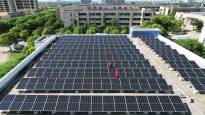Ember predicts that 2023 will go down in history as the peak year for emissions in the energy production sector, as next year emissions will start to decrease.
Petri Burtsoff,
Veikko Eromäki
Fresh from Ember, a think tank that follows the international energy transition of the Global Electricity Review 2024 report According to
If nuclear power is included as a low-emission form of electricity production, as much as 40 percent of the electricity produced last year was produced by low-emission means.
The record was achieved mainly thanks to the investments made in wind and solar power.
In 2023, the production of solar energy on Earth increased by 23 percent, wind power by 10 percent.
If the amounts are compared to the year 2000, the change has been significant. At that time, 19 percent of global electricity production came from renewable sources, and only 0.2 percent was produced by wind and solar power.
The information is based on data collected from a total of 215 countries.
The emission peak of electricity production has been reached
According to Ember, renewable electricity production could have caused a drop in emissions from the world’s energy production sector last year.
However, this did not happen, because due to the drought, the lack of hydropower was replaced by the use of coal-fired power plants.
In any case, Ember predicts that 2023 will go down in history as the peak year for emissions in the energy production sector, when in 2024 even more renewable electricity production will be used.
The biggest single factor in the change in electricity production last year was China, whose share of new renewable electricity production was no less than 51 percent for solar power and 60 percent for wind power.
